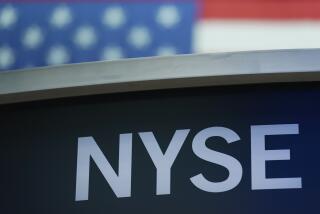Central Banks’ Selling Drives Dollar Lower
- Share via
NEW YORK — Nine central banks launched a new wave of open-market dollar sales today, driving the U.S. currency lower in their fourth-straight trading day of intervention.
Dealers said the banks appeared determined to stamp out any rebound by the dollar after they had hit it particularly hard last week by dumping up to $2 billion on the market to stop a disruptive new-year rally.
They struck again today when new buying lifted the dollar near 1.85 West German marks. The dollar had opened higher in slow New York trading, with cautious optimism resurfacing for the currency, but the intervention soon took it lower.
sh Numerous Banks
The Federal Reserve sold dollars around the day’s high of 1.8480 marks. It was joined by the Bundesbank, the Bank of Canada and six other European central banks.
At 12:30 p.m. EST the dollar stood at 1.8330 West German marks and 127.65 Japanese yen, down from 1.8375 marks and 127.75 yen at Friday’s close.
The dollar stumbled last week after the central banks’ selling and coordinated interest-rate increases in Europe, which brought the U.S. currency off its three-month highs against the West German mark. Firm U.S. rates and hopes that the Bush Administration will sharply cut the budget deficit had bolstered the currency.
Some Caution Abroad
But the new central-bank dollar selling has sown new caution into the foreign exchange market, keeping a lid on the dollar’s upside potential, dealers said.
“It seems like more people are letting dollars out,” said Charles Spence of First Interstate Bank. “The top side is limited by the central bank intervention.”
Much of today’s activity focused on dollar-mark trading. The yen has shown little movement, given the continued absence of the Bank of Japan from the central bank intervention.
But traders said there was still some support for the dollar. “It’s an orderly decline,” said Stuart Frost of National Westminster Bank, adding that underlying corporate demand was still evident for dollars. “I still believe people want to buy dollars.”
This week’s key U.S. economic indicator is expected to be Friday’s release of fourth-quarter gross national product. Economists forecast the GNP to rise by 2.4%, down from 2.5% in the previous quarter. But excluding the effects of the drought, growth last quarter would have been higher.
Gold for February delivery was down 60 cents at $408.60 in midday trading on the Commodity Exchange in New York.
More to Read
Inside the business of entertainment
The Wide Shot brings you news, analysis and insights on everything from streaming wars to production — and what it all means for the future.
You may occasionally receive promotional content from the Los Angeles Times.










